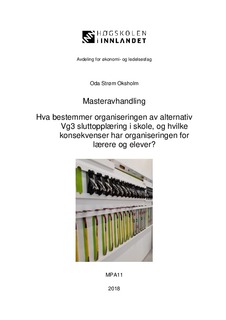Hva bestemmer organiseringen av alternativ Vg3 sluttopplæring i skole, og hvilke konsekvenser har organiseringen for lærere og elever?
Abstract
Problemstillingen i denne masteravhandlingen er hva som bestemmer organiseringen av alternativ Vg3 sluttopplæring i skole, og hvilke konsekvenser det har for lærere og elever. Bakgrunnen for studien er at det finnes lite informasjon om hvordan de ulike fylkene organiserer alternativ Vg3 sluttopplæring i skole, og om det organiseres ulikt. Alternativ Vg3 sluttopplæring i skole er et tilbud for elever som ikke får læreplass, slik at de kan fullføre sin yrkesfaglige utdanning. Det er fylkeskommunen som er ansvarlig for videregående opplæring, og herunder yrkesfaglig opplæring. Metoden jeg valgte å bruke var kvalitative intervju med 12 informanter fra tre ulike fylker. Analyse av data ble gjort etter metoden beskrevet av Graneheim og Lundman. Masteravhandlingen er godkjent av NSD. Funne fra intervjuene er at dette er en sammensatt elevgruppe. En stor andel av elevene har sosiale og faglige utfordringer i tillegg til at de ikke har fått læreplass. Alternativ Vg3 sluttopplæring i skole er hovedsakelig et individuelt utformet tilbud, og den mest utbredte organiseringen er å utplassere elevene i kortere eller lengre tid i bedrift. Lærerne har stor påvirkning på utformingen av alternativ Vg3 sluttopplæring i skole. Det er mye motvilje mot ordningen og mangelfulle støttesystemer på flere forvaltningsnivå. Dette fører til at mange lærere opplever at de er alene med ansvaret, noe som ofte oppleves som belastende. Det er også et forbedringspotensial i det fylkeskommunale samarbeidet, som for eksempel mangelfull informasjon om elever med spesielle behov og manglende informasjon om ordningen.
I masteravhandlingen kommer det fram at det er mange aktører som påvirker og bestemmer hvordan organiseringen er utformet. Nasjonale aktører, fylkeskommunale aktører og aktører på skolene har alle innflytelse på utformingen av tilbudet. Mangelen på både retningslinjer og politiske føringer medfører et stort vakuum i hvordan tilbudet skal utformes, noe som medfører at skoler og enkeltlærer får ansvaret for utformingen. En konsekvens av manglende retningslinjene er at lærerne må ta et stort ansvar for utarbeiding og oppfølging av tilbudet. Dagens ordningen innebærer også at elevene som ikke har fått læreplass får et år mindre opplæring enn elevene som har fått læreplass. Det er et behov for en standardisering av alternativ Vg3 sluttopplæring i skole slik at alle elevene er sikret et godt tilbud. Engelsk sammendrag (abstract)
The topic in this master thesis is what determines the organization of “alternativ Vg3 sluttopplæring i skole”, and what the consequences are for teachers and students. The background of this study is a lack of knowledge about how the different counties organize “alternativ Vg3 sluttopplæring i skole” and if it is organized differently. “Alternativ Vg3 sluttopplæring i skole” is a program offered to students who do not get an apprenticeship, so that they can complete their vocational education. The county administration is responsible for upper secondary education, including vocational education. The choice of method was qualitative interview with 12 informants from three different counties. Data analysis was completed according to the method described by Graneheim and Lundman. The master thesis is approved by NSD. The results from the interviews shows that the student group is complex. A large proportion of students have social and educational challenges in addition to lacking an apprenticeship. “Alternativ Vg3 sluttopplæring i skole” is individually designed, and students receive training in different companies for a limited time. Teachers have a major influence on the design of “alternativ Vg3 sluttopplæring i skole”. There is some opposition in the county administrations to the education model and there support system is inadequate. This leaves many teachers feeling abandoned, with a heavy burden of responsibility for the program on their shoulders. There is also an improvement potential in county-municipal cooperation, when it comes to withholding information about students with special needs and lack of information about the education model. The master thesis reveals that there are many actors who influence and decide how the education model is designed. National actors, county municipal actors and actors in schools all have an influence on the design of the education model. The lack of policies leads to a vacuum in how the education is to be designed, which means that schools and individual teachers are responsible for the design. A consequence of the lack of guidelines is that teachers must take greater responsibility. The system of today also means that students who have not received an apprenticeship receive one year less education than the students who have an apprenticeship. There is a need for a standardization of “alternativ Vg3 sluttopplæring i skole” so all students are guaranteed a good education.
Description
Erfaringsbasert master, 90 studiepoeng.
